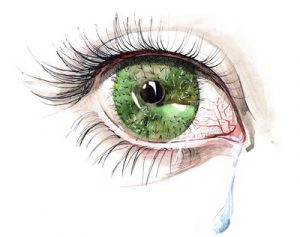Dry Eye Disease is a chronic progressive inflammatory disorder that benefits from early treatment. If you have symptoms of dryness (chronic redness, burning, watery, itching, tired or heavy eyelids, discomfort with contact lenses, fluctuating vision, and gritty or sandy sensation) then you should schedule an appointment with an optometrist. Having a customized treatment plan is important because there are different types of dry eye and the signs and symptoms vary from person to person.
 A thorough history including symptoms, past and current dry eye treatments, and medical history and medication will be reviewed. During the examination a microscope is used to look at the health of the front of the eyes, such as the cornea and conjunctiva. Special colored dyes will be added to view the tear film and identify the type and severity of dryness. We also assess the glands along the eyelids that often become blocked and cause symptoms of dry eye. At the end the exam, a customized course of therapy will be recommended.
A thorough history including symptoms, past and current dry eye treatments, and medical history and medication will be reviewed. During the examination a microscope is used to look at the health of the front of the eyes, such as the cornea and conjunctiva. Special colored dyes will be added to view the tear film and identify the type and severity of dryness. We also assess the glands along the eyelids that often become blocked and cause symptoms of dry eye. At the end the exam, a customized course of therapy will be recommended.
Dry eye is one possible cause of watery eyes. The eyes often water or tear as a reaction to irritation, such as dry eyes. But these tears are not good at lubricating the eye because they don’t contain mucous and oil.
There are many different treatments available, depending on the severity and type of dry rye. Since there are so many, I want to focus on just a few of them.
A common cause of dry rye is evaporation, which is due to a lack of oil in the tears. This can happen if the glands along the eyelid are clogged. We offer an in-office procedure to cleanse the oil out of the glands. We advise using a heated eye mask at home every night for ten minutes to maintain the glands. Omega-3, an anti-inflammatory oil supplement, can also help relieve the signs and symptoms of dry eye [maybe add more about PRN omega-3 supplement].
A new prescription strength daily lid cleaner, called Avenova, has shown promising results for all types of dry rye. There are also prescription strength eye drops available. Some patients with dry eye symptoms benefit from a punctal plug, which is a small implant that prevents tears from draining out of the eye. With so many options available, it is important to discuss the best treatment course with your doctor.
 Dry eye is more common as we age. It is also more common in women, especially when there are changes in hormone levels during pregnancy and with hormone replacement therapy. Those with autoimmune diseases and diabetes also experience dry eye symptoms. Some medications have a side effect dry eyes, for example antihistamines.
Dry eye is more common as we age. It is also more common in women, especially when there are changes in hormone levels during pregnancy and with hormone replacement therapy. Those with autoimmune diseases and diabetes also experience dry eye symptoms. Some medications have a side effect dry eyes, for example antihistamines.
